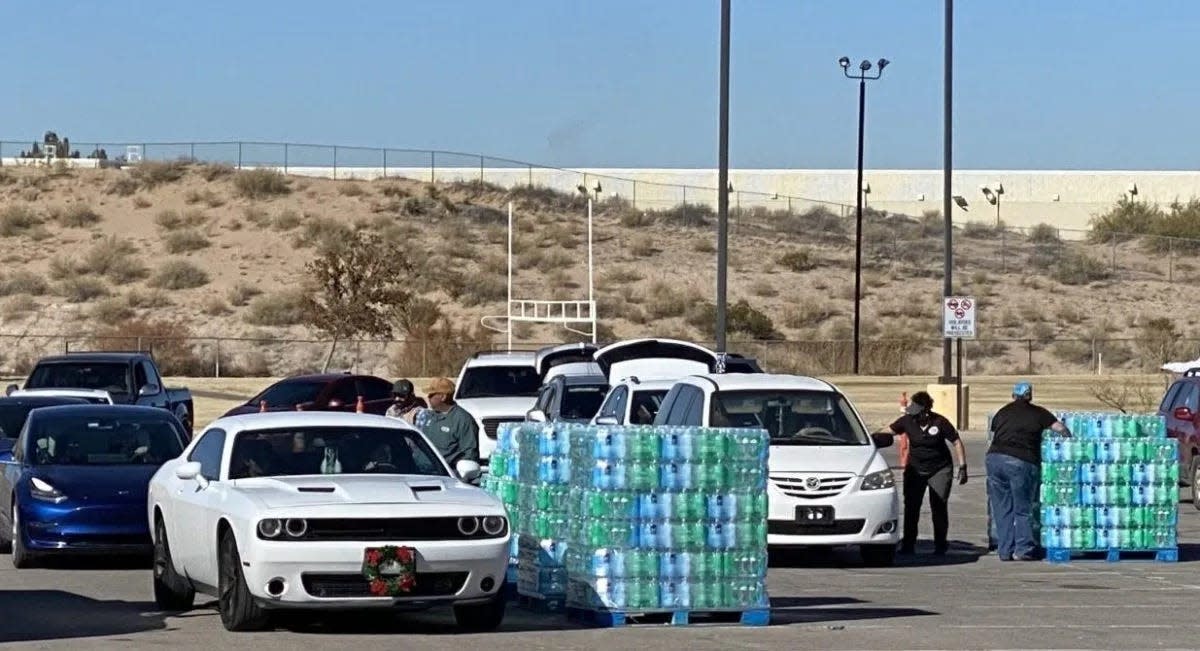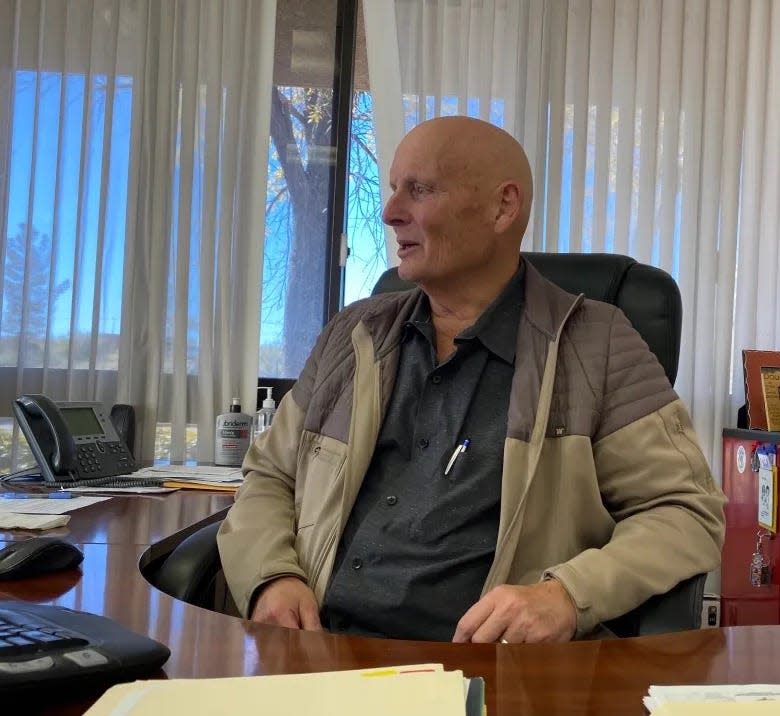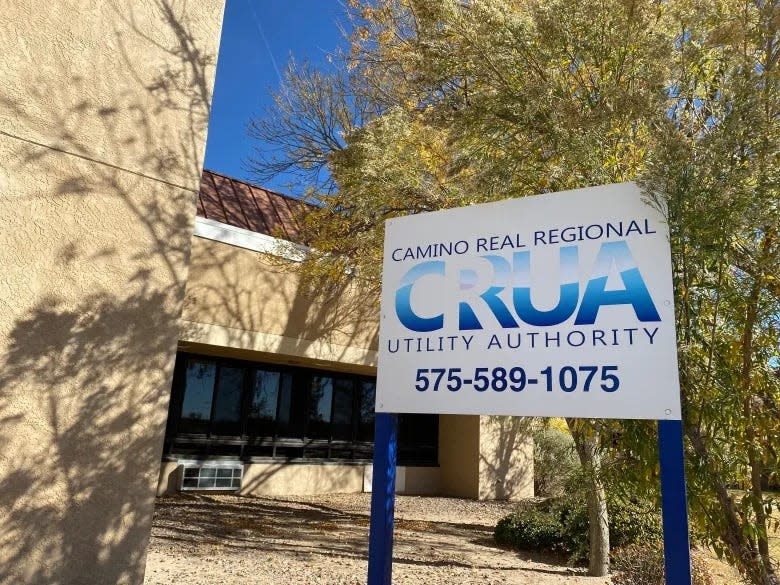Clean water returns to Santa Teresa, Sunland Park after slimy substance flowed from taps for days

Residents across Santa Teresa and Sunland Park spent days without potable water until Monday afternoon, five days after a malfunction at a nearby water treatment plant run by the Camino Real Regional Utility Authority caused slimy, unusable water to flow from taps across the area.
Officials with CCRUA on Monday said they were working to return the chemical composition of water in the utility’s system back to normal. By Monday afternoon the utility said water was safe to drink throughout the area, except at the Santa Teresa Industrial Park near the port of entry, where water was still unusable as of Tuesday morning.
Workers with Doña Ana County – which oversees the utility – have been distributing bottled water at the Sunland Park Sports Complex since Friday for customers without access to potable water at home.
The water pH in the area became excessively high, meaning the water was too basic to drink and had a slippery, slimy texture.
More: Son accused of murder in father's fatal stabbing at Central El Paso home
By Monday afternoon, CRRUA restored water service to the last two residential areas without clean water, Villa Valencia and Valencia Park off of Pete Domenici Highway. As many as eight subdivisions in the area were without water over the weekend.
“After water samples have been tested by CRRUA certified operators with calibrated machines,” the affected neighborhoods “are showing standard pH levels.” But CRRUA said customers should turn on all the faucets in their residence and run water for 20 minutes to flush the system.
“CRRUA personnel is optimistic that the industrial park will be cleared (Tuesday), once a reading of 8.5-8.6 pH level is reached,” the utility posted in an online update Monday afternoon.

Brent Westmoreland, executive director of CRRUA, said the problem originated at one of the utility’s four water treatment plants that remove arsenic from the water.
“The chemical pump that returns the water back to normal pH, once the arsenic has been removed, did not shut off when the pumps shut off. It’s supposed to be on automatic, but it malfunctioned,” Westmoreland said in an interview Monday at his office off of McNutt.
“Wednesday, when we learned of this issue, we researched where it was coming from, found that, shut that pump down and then started draining pipes, flushing them and draining tanks and putting fresh water in them.”
CRRUA didn’t alert customers about the problem until Friday.
“We, not knowing the extent of it and the cause, did not see fit to instill hysteria and fear until we knew for sure what we were dealing with,” Westmoreland said.
Any residents in the area who drank or used water from CRRUA between last Wednesday and Friday – the time when pH levels first became elevated and the time officials alerted the public – “should be just fine,” Westmoreland said.
He said the utility has started exploring the cause of the problem to prevent it in the future.
“We have already notified technicians and electricians to come in and research this and make corrections,” he said.
However, Delia Ugalde, a longtime resident of the Villa Valencia neighborhood, said Monday she was hoping for some kind of reimbursement from the utility.
“To me, it was man-made error” that caused the lack of safe water, said Ugalde, who added Monday that she hadn’t had potable water at her home for four days.
“They gave you one little case of water. What are you going to do with that? … What’s a big family to do?” Ugalde said of the county’s water distribution. “Yesterday, I had to wash my hair with bottled water. After three days I thought ‘Ok, I have to do it.’”
More: Countdown to Christmas: 24 days of family-friendly holiday activities

The utility hasn’t finalized any plans for a potential refund, but customers who went without clean water likely shouldn’t anticipate a big reimbursement.
“The just reimbursement would be the water that it takes to flush their house and let the new water in,” Westmoreland said. “That’s about as good as we can do.”
Over at the industrial park just west of Santa Teresa – where local leaders in recent years have been courting companies to build high-tech manufacturing facilities – most operators aren’t big water users and weren’t complaining much about the lack of potable water, said Jerry Pacheco, president and CEO of the Border Industrial Association, a trade group that represents businesses in the industrial park.
Pacheco said one company in the area contacted them about slimy water, but he hasn’t heard major concerns from any other manufacturers operating in the industrial park. He said he wasn’t worried the incident would dissuade companies from investing in the area in the future because of concerns over water availability.
Overall, Pacheco said the water contamination appeared to be a “one-time thing” and not a signal of mismanagement or of an ongoing systemic problem at CRRUA, he said.
Westmoreland said CRRUA and El Paso Water are unconnected utilities, and there’s no risk of the problem at the utility’s arsenic treatment plant somehow spreading to affect customers in El Paso.
“We’re not interconnected at all” with El Paso Water, Westmoreland said. “I’ve been getting calls from people on the Texas side wondering what they need to do. It’s not in your area. You’re in El Paso Water’s area, and I don’t believe they have any alerts out right now.”
El Paso Water and CRRUA are “apples and oranges,” he said. “They have nothing in common.”
In a written response to questions, El Paso Water said: “There is no connection between EPWater’s system and CRRUA’s system, so it is impossible for the water quality problems from the CRRUA water system to affect EPWater customers.”
Still, there’s little information readily available to customers about CRRUA’s finances or operations, creating a lack of visibility into the utility, which is dwarfed by El Paso Water in size and complexity. CRRUA served 18,000 customers in Santa Teresa and Sunland Park as of 2014, according to its nine-year-old master plan, the most recent report from the utility that gives much insight into its operations.
In a 2022 report detailing the quality of water in CRRUA’s system, federal water regulators found that the level of arsenic in the water was excessively high and violated standards. Arsenic levels were more than 6 times higher in CRRUA’s water samples compared with El Paso Water’s samples, according to both utilities’ 2022 water quality reports.
In response, CRRUA said last year that it hired a contractor to “complete the construction of the new Arsenic System and hope to have (it) completed and operational by the end of 2022.” It’s not clear if the malfunction at the treatment plant was related to the work on a new arsenic system.
Ugalde, the CRRUA customer and Santa Teresa resident, was frustrated at the water problem and the lack of clarity over potential compensation. But going forward, she said the extra scrutiny on CRRUA should help prevent another local water crisis.
“I’m kind of leery,” of the local water supply after the incident, Ugalde said. However, “I think, really, they’re going to be more careful as to what they’re doing after they learned their lesson.”
This article originally appeared on El Paso Times: Slimy water cleared after five days in Santa Teresa and Sunland Park

